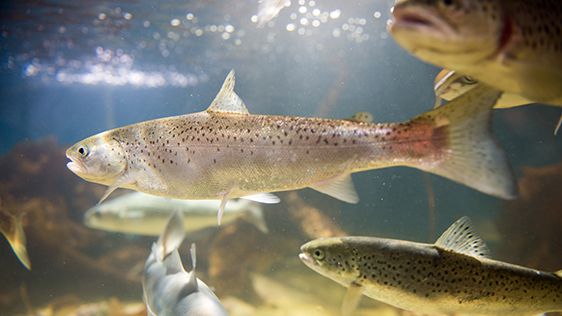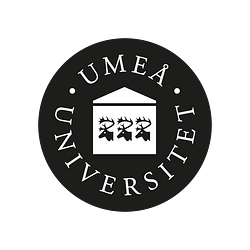
Press release -
Salmon genome mapped in vast research project
The entire salmon genome has been mapped in a large project, which involved researchers at Umeå University. The results published in the journal Nature provide better chances of protecting salmon farms from viruses, but also of preserving the wild salmon species for the future.
“The salmon genome contains two copies of each gene. Speculations have covered if these copies have given evolution the free rein necessary to develop some of the salmon’s special traits, for instance the red flesh or the ability to live in fresh water as young and in salt water as an adult,” says Torgeir Hvidsten, visiting professor at Umeå Plant Science Centre and professor at the Norwegian University of Life Sciences.
Professor Hvidsten is one of the researchers who has participated in the mapping and systematisation of the salmon genome. The research project has been carried out over six years in collaboration between researchers and industry representatives in Sweden, Norway, Canada, Chile, China and the US as well as research councils in several of these countries.
The mapping of the salmon genome is of the same quality as the one on the human genome. To fully understand the entire salmon genome is necessary in order to use modern gene technology to further develop salmon breeding. The fish with the best traits today is not necessarily the one best adapted to handle new illnesses, environmental change or new types of feed.
An example is the IPN virus, an illness that has struck numerous salmon farms. As many as 90 per cent of the contaminated fish die with huge economic loss as a result. The solution to the problem was not found until the researchers had access to the salmon genome sequence and could identify which gene makes fish resistant against the IPN virus. At present, breeders can make sure that carriers of IPN resistance can continue to be used in fish breeding. Therefore, the number of IPN cases in salmon has reduced by 90 per cent in a few years.
Apart from securing sound fish breeding, the mapping of the salmon genome is also important in the effort to preserve the wild salmon. In two new research projects, Aqua Genome Project and QuantEscape, the salmon genome sequence is used to map the genetic variation in Norwegian salmon streams. This makes it possible with high precision to separate the wild salmon from bred salmon that have escaped from farms and to determine to what extent the bred salmon affects the wild salmon.
The knowledge of the salmon genome also provides vital insight in the evolutionary biology. 80 million years ago, the ancestor of all salmonid fishes had its genome duplicated. Instead of 25 chromosomes, it suddenly had 50 chromosomes. When this mother salmon got a “backup copy” of all genes, it meant that the spare copies were able to mutate or develop completely new functions.
Similar duplications of the genome took place in the species of vertebrates that resulted in both fish and humans. But this took place 400–500 million years ago, which has made the evidence of the evolution process unclear over time and opens up for various interpretations. 80 million years is a shorter span of time, which means that researchers with more certainty are able to decipher what happens when the genome is duplicated and how the duplicated gene can change what the genes govern over in an organism.
”We compared salmon to pike – a species closely related to salmon – but pike only has one copy of each gene,” says Torgeir Hvidsten. “We found that the most common trait in salmon was that one copy of the gene was expressed in the same tissue as in the pike, for instance in the liver, whereas the other copy was expressed in other tissues, for instance in the gills. This indicates how gene duplication can lead to biological innovation; the spare copy is free to experiment, so to speak.”
Torgeir Hvidsten took part in the research project at Umeå Plant Science Centre that in 2013 was able to present a full mapping of the spruce genome, also published in Nature.
“It felt natural to go from Christmas trees to spiced salmon. The methods used are nearly completely identical regardless of what organism we study,” he says.
Read the digital publication in the journal Nature
About the publication:
Nature, article: Atlantic salmon genome provides insights into rediploidization by Sigbjørn Lien, Ben F. Koop, Simen R. Sandve, Jason R. Miller, Matthew P. Kent, Torfinn Nome, Torgeir R. Hvidsten, Jong S. Leong, David R. Minkley, Aleksey Zimin, Fabian Grammes, Harald Grove, Arne Gjuvsland, Brian Walenz, Russell A. Hermansen, Kris von Schalburg, Eric B. Rondeau, Alex Di Genova, Jeevan K. A. Samy, Jon Olav Vik, Magnus D. Vigeland, Lis Caler, Unni Grimholt, Sissel Jentoft, Dag Inge Våge, Pieter de Jong, Thomas Moen, Matthew Baranski, Yniv Palti, Douglas R. Smith, James A. Yorke, Alexander J. Nederbragt, Ave Tooming-Klunderud, Kjetill S. Jakobsen, Xuanting Jiang, Dingding Fan, Yan Hu, David A. Liberles, Rodrigo Vidal, Patricia Iturra, Steven J. M. Jones, Inge Jonassen, Alejandro Maass, Stig W. Omholt,William S. Davidson. DOI: http://dx.doi.org/10.1038/nature17164
For more information, please contact:
Torgeir Hvidsten, visiting professor, Umeå Plant Science Centre, Umeå University and professor at the Norwegian University of Life Sciences
Phone: +4747957383
Email: torgeir.hvidsten@umu.se
Topics
Categories
Umeå University
Umeå University is one of Sweden's largest institutions of higher learning with over 32,000 students and 4,200 employees. We have a well-established international research profile and a broad range of study options. Our campus constitutes an inspiring environment that encourages interdisciplinary meetings - between students, researchers, teachers and external stakeholders. Through collaboration with other members of society, we contribute to the development and strengthen the quality of our research and education.

